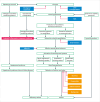Recent developments in the management of ascites in cirrhosis
- PMID: 38340308
- PMCID: PMC10954428
- DOI: 10.1002/ueg2.12539
Recent developments in the management of ascites in cirrhosis
Abstract
In recent years, advances have been made for treating ascites in patients with cirrhosis. Recent studies have indicated that several treatments that have been used for a long time in the management of portal hypertension may have beneficial effects that were not previously identified. Long-term albumin infusion may improve survival in patients with cirrhosis and ascites while beta-blockers may reduce ascites occurrence. Transjugular intrahepatic porto-systemic shunt (TIPS) placement may also improve survival in selected patients in addition to the control with ascites. Low-flow ascites pump insertion can be another option for some patients with intractable ascites. In this review, we summarize the latest data related to the management of ascites occurring in cirrhosis. There are still unanswered questions, such as the optimal use of albumin as a long-term therapy, the place of beta-blockers, and the best timing for TIPS placement to improve the natural history of ascites, as well as the optimal stent diameter to reduce the risk of shunt-related side-effects. These issued should be addressed in future studies.
Keywords: albumin; ascites; ascites pump; liver cirrhosis; transjugular intrahepatic porto‐systemic shunt.
© 2024 The Authors. United European Gastroenterology Journal published by Wiley Periodicals LLC on behalf of United European Gastroenterology.
Conflict of interest statement
The authors have no conflicts of interest to declare.
Figures


Similar articles
-
The role of transjugular intrahepatic portosystemic shunt in patients with cirrhosis and ascites: Recent evolution and open questions.Hepatology. 2023 Feb 1;77(2):640-658. doi: 10.1002/hep.32596. Epub 2022 Jun 20. Hepatology. 2023. PMID: 35665949 Review.
-
An update on the pathogenesis and clinical management of cirrhosis with refractory ascites.Expert Rev Gastroenterol Hepatol. 2019 Apr;13(4):293-305. doi: 10.1080/17474124.2018.1555469. Epub 2018 Dec 12. Expert Rev Gastroenterol Hepatol. 2019. PMID: 30791777 Review.
-
Management of refractory ascites.Clin Mol Hepatol. 2023 Jan;29(1):16-32. doi: 10.3350/cmh.2022.0104. Epub 2022 Jun 9. Clin Mol Hepatol. 2023. PMID: 35676862 Free PMC article. Review.
-
Long-term clinical outcome of patients with cirrhosis and refractory ascites treated with transjugular intrahepatic portosystemic shunt insertion.J Gastroenterol Hepatol. 2015 Feb;30(2):389-95. doi: 10.1111/jgh.12725. J Gastroenterol Hepatol. 2015. PMID: 25168607
-
Management of ascites in cirrhosis.Clin Liver Dis. 2005 Nov;9(4):715-32, viii. doi: 10.1016/j.cld.2005.07.008. Clin Liver Dis. 2005. PMID: 16207572 Review.
Cited by
-
Pharmacological Treatment of Ascites: Challenges and Controversies.Pharmaceuticals (Basel). 2025 Feb 27;18(3):339. doi: 10.3390/ph18030339. Pharmaceuticals (Basel). 2025. PMID: 40143117 Free PMC article. Review.
-
PHF20L1: An Epigenetic Regulator in Cancer and Beyond.Biomolecules. 2025 Jul 18;15(7):1048. doi: 10.3390/biom15071048. Biomolecules. 2025. PMID: 40723918 Free PMC article. Review.
-
Neutrophil percentage-to-albumin ratio as predictor for mortality in patients undergoing endoscopic intervention for variceal hemorrhage.Eur J Med Res. 2025 Apr 26;30(1):329. doi: 10.1186/s40001-025-02489-4. Eur J Med Res. 2025. PMID: 40281590 Free PMC article.
-
Drainage of ascites in cirrhosis.World J Hepatol. 2024 Sep 27;16(9):1245-1257. doi: 10.4254/wjh.v16.i9.1245. World J Hepatol. 2024. PMID: 39351514 Free PMC article. Review.
References
Publication types
MeSH terms
Substances
LinkOut - more resources
Full Text Sources

